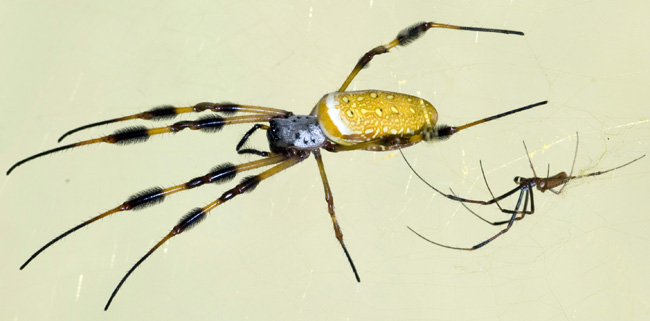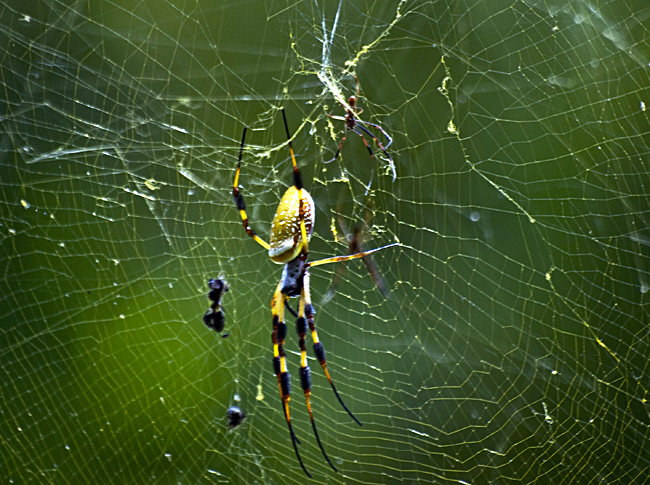Arachnophobia and Fabric
Today, arachnophobia and fabric. The University of Houston's College of Engineering presents this series about the machines that make our civilization run, and the people whose ingenuity created them.
I recently visited Brazos Bend State Park, just south of Houston. It's a lovely wildlife preserve, teeming with birds, alligators, and all the other elements of rich wetlands. Walking along, taking it all in, I suddenly had to duck around a large web with a truly intimidating spider in the middle of it. I photographed her.
Only later, when I saw the blown up picture, did I realize how fearsome she was -- four inches across, in the huge web she'd woven across the trail. She had two furry bands on each of four forelegs. And there, lurking by her, I saw her small mate -- Casper Milquetoast cowering behind his fur-trimmed Mongol War Queen.


This elegant lady was a reminder of the bad rap spiders get. (If you want to dress up a horror movie, all you do is run few spiders by the camera.) She's a member of the Nephila family. She's called a Golden Silk Orb-Weaver because she weaves her shimmering threads into a web of circular rings.
So how much peril was I in that day? Well, her venom is similar to that of a Black Widow spider, but much less potent. If she'd bitten me, she'd probably have raised a welt. But this spider would rather run than attack. She was no threat.
Orb-weavers come in several forms. And they've long attracted people to the problem of making useful things from their threads. Eight Australian Orb-Weavers perished over north Texas in Space Shuttle Columbia, in 2003. They'd been flown to Cape Canaveral from the Melbourne Zoo so their web-weaving could be observed in microgravity. Twenty-two more orb-weavers hadn't made the final cut, and didn't join the flight. They were returned to Melbourne to spend the remainder of their lives on display.
That star-crossed venture calls to mind another failed study, 137 years earlier. A young anatomist named Burt Wilder set out to extract Nephila silk and weave fabric from it. This was not the first such attempt; it'd been tried earlier in Europe. But Wilder took it to its limits. He created an apparatus to hold the spider, while he drew out a long single thread.
One spider took just 75 minutes to spin 450 feet of thread. That's six feet per minute. The catch is; a yard of silk fabric would've taken the output of over four hundred spiders. Wilder's work did not result in a new silk production industry.
However, researchers at Shinshu University in Japan have come up with an angle. They inject genes of my Nephila spider into silkworm eggs. The resulting silkworms now produce a kind of spider-silk-enriched fiber. The work's funded by the Okamoto Corporation in the historic town of Nara. They've made strong warm socks from the fiber and are tooling up to market them.
Well, I knew none of this, that summer morning at Brazos Bend. But I now find that I'd met a very special fellow creature -- as she glistened, straw-gold, in the muted sun of a new day.
I'm John Lienhard at the University of Houston, where we're interested in the way inventive minds work.
For some more denizens of Brazos Bend State Park, Click Here. For more on spiders, see W. J. Gertsch, American Spiders. (New York: Van Nostrand Reinhold Co., 1979). See pp. 60-62 for more on Wilder's work.
See also, the Wikipedia article on the Golden Silk Orb Weaver, Nephila Clavipes, or its Japanese cousin, Nephila Clavata.
This site describes the properties of Nephila silk.
See the Japanese genetically-altered silkworms here.
See also, Episodes 1068, 1069, and 1717, for more on spider silk and its use. Also, listener Fred Rogers writes to point out that two orb weaver spiders were delivered to the International Space Station in Nov. 2008 for continued study. Once in space, they spun beautifully symmetrical webs.
Note Added Sept 18, 2014: Jo Anne Davis from Brazos Bend Park points out a tapestry that has been woven from Orb-Weaver silk in Mexico City. See: http://www.wired.com/2009/09/spider-silk/.
